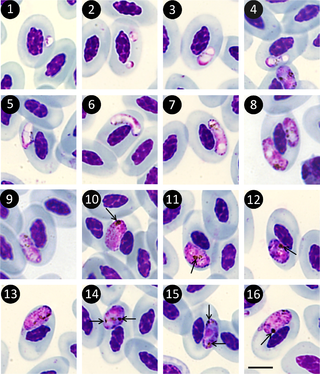Hepatocystis vassali is a species of parasitic protozoa that infect mammals.
Hepatocystis pteropi is a species of parasitic protozoa. The vertebrate hosts are mammals.
Megaloschizonts are large schizonts that produce extremely high numbers of merozoites. They are found in various species of the Phylum Apicomplexa. The Apicomplexa phylum contains several parasitic protozoans. They have a very complex life cycle that includes several stages. Megaloschizonts and the smaller schizonts are the part of the life cycle that takes place inside the infected host organism and operates as an asexually reproductive cell. Megaloschizonts appear as grey-white nodules found in the smooth muscle of major organs, such as the heart, liver, lung or spleen.

The Haemosporida are an order of intraerythrocytic parasitic alveolates.
Hepatocystis is a genus of parasites transmitted by midges of the genus Culicoides. Hosts include Old World primates, bats, hippopotamus and squirrels. This genus is not found in the New World. The genus was erected by Levaditi and Schoen, 1932, as Hepatocystes.
Protococcidiorida is an order within the subclass Conoidasida of the phylum Apicomplexia. All members of this order are parasitic protozoa. The order was created by Kheisin in 1956.
Hepatocystis bainae is a species of parasitic alveolates belonging to the phylum Apicomplexa
Hepatocystis carpenteri is a species of parasitic protozoa. They are transmitted by flies of the genus Culicoides and infect mammals.
Hepatocystis hipposideri is a species of parasitic protozoa. They are transmitted by flies of the genus Culicoides and infect mammals.
Hepatocystis muuli is a species of parasitic protozoa. They are transmitted by flies of the genus Culicoides and infect mammals.
Hepatocystis perronae is a species of parasitic protozoa. They are transmitted by flies of the genus Culicoides and infect mammals.
Hepatocystis taiwanensis is a species of parasitic protozoa. They are transmitted by flies of the genus Culicoides and infect monkeys.
Barrouxia is a genus of parasitic alveolates belonging to the phylum Apicomplexa.
Defretinella is a genus of parasitic alveolates of the phylum Apicomplexa.
Selenidioides are a genus of parasitic alveolates in the phylum Apicomplexa. Species in this genus infect marine invertebrates.
The Selenidioididae are a family of parasitic alveolates in the phylum Apicomplexa. Species in this order infect marine invertebrates.
The Diplocystidae are a family of parasitic alveolates in the phylum Apicomplexa.
The Monocystidae are a family of parasitic alveolates in the phylum Apicomplexa.
Apicystis is a genus of parasitic alveolates of the phylum Apicomplexa.
Menzbieria is a genus of parasitic alveolates of the phylum Apicomplexa.
